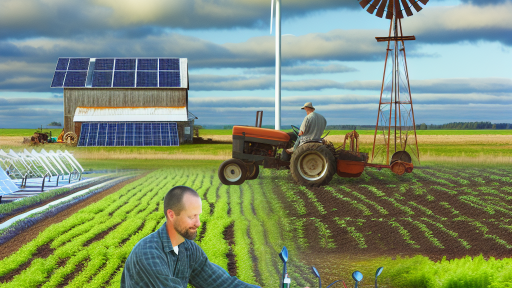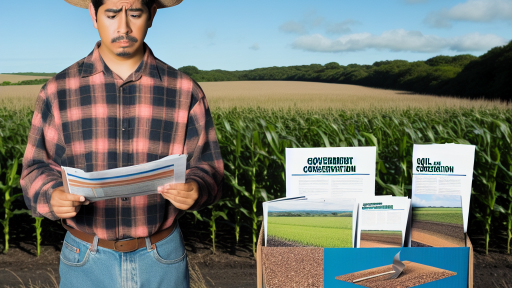Understanding the Importance of R&D in Agriculture
Enhancing Crop Yields
Research and development play a crucial role in enhancing crop yields.
Innovations in seed genetics lead to more resilient varieties.
New farming techniques also contribute to increased productivity.
Moreover, R&D helps farmers adapt to changing climate conditions.
Improving Pest and Disease Management
Effective R&D provides valuable insights into pest and disease management.
Farmers can benefit from integrated pest management practices.
Research helps in developing safer and more effective pesticides.
This approach reduces crop loss and ensures food security.
Promoting Sustainable Practices
R&D facilitates the development of sustainable farming methods.
These practices minimize environmental impact and conserve resources.
Furthermore, they enhance soil health and biodiversity.
Investing in R&D leads to innovative strategies for sustainable agriculture.
Fostering Economic Growth
Investing in agricultural R&D promotes economic growth and job creation.
New technologies can lead to improved efficiency and profitability.
Research initiatives increase competitiveness in the global market.
Transform Your Agribusiness
Unlock your farm's potential with expert advice tailored to your needs. Get actionable steps that drive real results.
Get StartedAdditionally, strong R&D supports local communities and farmers’ livelihoods.
Encouraging Collaboration and Knowledge Sharing
R&D fosters collaboration among farmers, researchers, and agribusinesses.
This collaboration facilitates the sharing of best practices and knowledge.
Furthermore, partnerships can lead to breakthrough innovations.
It creates a network that empowers farmers to thrive.
Identifying Potential Funding Sources for Agricultural Research
Government Grants
Government grants serve as a significant funding source for agricultural research.
Various federal programs specifically focus on enhancing agricultural productivity.
Examples include the USDA’s National Institute of Food and Agriculture.
Farmers can apply for grants aimed at innovative research projects.
Many state programs also offer funding opportunities tailored to local needs.
Private Sector Investments
The private sector presents an array of funding options for agricultural research.
Companies often invest in research to enhance their product offerings.
Collaborating with businesses can provide access to vital resources.
Consider partnerships with agritech firms seeking innovative solutions.
Private foundations also support various research initiatives.
Agricultural Cooperatives
Agricultural cooperatives play a crucial role in funding research efforts.
These organizations can pool resources for collective research projects.
Members benefit from shared knowledge and innovation.
Cooperatives often seek external funding to enhance their research capabilities.
Join a cooperative to tap into these collaborative opportunities.
Non-Profit Organizations
Non-profit organizations frequently support agricultural research funding.
They aim to address specific agricultural challenges through research.
Research initiatives aligned with their missions often receive grants.
Engage with non-profits focusing on sustainability, food security, and innovation.
Showcase Your Farming Business
Publish your professional farming services profile on our blog for a one-time fee of $200 and reach a dedicated audience of farmers and agribusiness owners.
Publish Your ProfileThese collaborations can lead to valuable funding opportunities.
International Funding Sources
International bodies also provide funding for agricultural research projects.
Organizations like the World Bank and FAO offer various grants.
These funds often target research that benefits developing countries.
Farmers conducting international research should explore these avenues.
Global partnerships can enhance funding prospects significantly.
Crowdfunding
Crowdfunding has emerged as a popular funding method for agricultural initiatives.
Online platforms allow farmers to present their research projects.
Engaging the community can lead to financial support from interested individuals.
Successful campaigns often utilize social media to spread awareness.
Creatively presenting research can attract numerous small investors.
Developing a Strong Proposal
Understanding the Funding Landscape
Research funding comes from various sources.
Public grants, private investments, and partnerships are key options.
Moreover, understanding the priorities of funders is essential.
Research the types of projects they support.
This knowledge helps tailor your proposal effectively.
Defining Your Project Goals
Clearly outline what you aim to achieve with your project.
Specific, measurable goals increase proposal success rates.
Identify challenges and how your project can address them.
This clarity demonstrates your project’s relevance.
Gathering Data and Evidence
Support your proposal with solid data.
Use statistics, case studies, and expert opinions.
This evidence boosts your credibility.
Additionally, show previous results to reinforce your case.
Creating a Detailed Budget
A well-prepared budget enhances your proposal.
Include all expected costs in your budget plan.
Justify each expense with clear explanations.
Moreover, consider showing how funds will be allocated.
This transparency builds trust with potential funders.
Highlighting Your Team’s Expertise
Showcase the qualifications of your project team.
Include bios that highlight relevant experience.
This evidence establishes your team’s capability.
Collaborations with experts can strengthen this section.
Engaging with Stakeholders
Involve stakeholders early in the proposal process.
Gather input from farmers, researchers, and communities.
Their perspectives can enhance your project design.
Furthermore, document their support in your proposal.
Writing with Clarity and Precision
Articulate your ideas using clear language.
Avoid jargon that might confuse non-experts.
Moreover, use headings and bullet points for structure.
Showcase Your Farming Business
Publish your professional farming services profile on our blog for a one-time fee of $200 and reach a dedicated audience of farmers and agribusiness owners.
Publish Your ProfileThis approach makes your proposal more readable.
Reviewing and Revising Your Proposal
After drafting, take time to review your proposal.
Seek feedback from colleagues or industry peers.
This input can uncover areas for improvement.
Consider revising multiple times for clarity and impact.
Submitting Your Proposal
Adhere to submission guidelines provided by funders.
Ensure all required documents accompany your proposal.
Follow up with a polite inquiry about your submission.
This demonstrates your commitment and professionalism.
Delve into the Subject: Farm-To-Table Legislation: Ensuring Transparency in Agricultural Supply Chains
Collaborating with Universities and Research Institutions for Funding
Building Partnerships
Farmers should actively seek partnerships with universities.
These collaborations can lead to valuable research opportunities.
Moreover, partnerships often provide access to funding resources.
Universities may have grants specifically for agricultural research.
Research institutions often have programs to support local farmers.
Identifying Research Areas
Farmers need to identify specific research areas relevant to their needs.
Focus on pressing challenges impacting their operations.
For instance, soil health and pest management are common concerns.
Additionally, exploring innovative crop varieties can be beneficial.
Engaging Students and Researchers
Involving students can enhance agricultural research projects.
Students often bring fresh ideas and perspectives.
Furthermore, they can assist with data collection and analysis.
By collaborating with researchers, farmers gain access to expert knowledge.
Seeking Grant Opportunities
Farmers should explore available grants for agricultural research.
Many public and private organizations offer such funding.
Moreover, local government agencies may have specific programs.
Farmers can check websites dedicated to agricultural funding resources.
Sharing Results and Impact
Once research is completed, it is vital to share the findings.
Farmers can present results at local agricultural fairs.
Additionally, publishing in agricultural journals can reach a broader audience.
Sharing impacts can attract more funding and research interest.
See Related Content: Innovations in Agricultural Insurance for Modern Farming
Utilizing Government Grants and Subsidies for Research Initiatives
Understanding Available Funding Sources
Farmers can access various government grants and subsidies.
These programs aim to support research initiatives.
Funding may come from federal, state, or local governments.
Each funding source has specific eligibility criteria.
It is crucial for farmers to research these options.
Identifying Qualified Programs
Farmers should start by identifying programs that suit their needs.
The USDA is a primary source of agricultural funding.
Additionally, various state departments also offer grants.
Showcase Your Farming Business
Publish your professional farming services profile on our blog for a one-time fee of $200 and reach a dedicated audience of farmers and agribusiness owners.
Publish Your ProfileLocal agricultural cooperative extensions may provide insights.
Online databases can help simplify the search process.
Preparing and Submitting Applications
Crafting a strong application is essential for success.
Farmers must clearly outline their project goals.
A detailed budget can demonstrate financial planning.
When necessary, include supporting data and research.
Following submission guidelines is crucial for approval.
Leveraging Networking Opportunities
Networking with other farmers can lead to valuable insights.
Attending workshops and conferences enhances knowledge.
Collaboration may help farmers strengthen their proposals.
Building relationships with researchers can be beneficial.
Consider seeking out local agronomists or agricultural specialists.
Monitoring and Reporting Progress
After receiving funding, tracking progress is vital.
Farmers should maintain accurate records of expenditures.
Regularly reporting findings can ensure transparency.
Adjustments may be needed based on ongoing results.
Staying compliant with funding requirements enhances credibility.
Uncover the Details: Navigating Food Safety Policies for Sustainable Farming

Engaging in Public-Private Partnerships for Enhanced R&D Funding
Understanding the Importance of Partnerships
Public-private partnerships play a crucial role in agricultural research and development.
These collaborations blend public resources with private sector innovation.
Farmers can leverage this synergy to access more funding opportunities.
Moreover, partnerships can help share the financial burden associated with R&D initiatives.
Identifying Potential Partners
Finding the right partners is essential for successful collaboration.
Farmers should explore partnerships with universities and research institutions.
Additionally, engaging with agricultural technology firms can yield significant benefits.
Networking events can facilitate connections between farmers and potential partners.
Moreover, attending industry conferences can provide valuable insights into potential collaborations.
Building Relationships
Establishing strong relationships leads to successful partnerships.
Trust and communication are vital for fostering collaborative efforts.
Farmers should actively engage with their partners regularly.
Setting clear goals and expectations enhances partnership efficiency.
Moreover, openly sharing results and learnings strengthens ties between partners.
Maximizing Funding Opportunities
Public-private partnerships can unlock unique funding sources.
Farmers should be proactive in researching available grants and programs.
Collaborating on grant applications increases the chances of success.
Furthermore, pooling resources together reduces individual financial risks.
Leveraging partner networks can discover additional funding options.
Measuring Impact and Success
Evaluating the effectiveness of partnerships is crucial for ongoing improvement.
Farmers should implement metrics to assess project outcomes.
Regular evaluations help identify strengths and areas for enhancement.
Showcase Your Farming Business
Publish your professional farming services profile on our blog for a one-time fee of $200 and reach a dedicated audience of farmers and agribusiness owners.
Publish Your ProfileAdditionally, reporting results can attract further funding opportunities.
Ultimately, demonstrating success will solidify future partnerships.
Explore Further: Benefits Of Conservation Programs For Sustainable Farming
Leveraging Technology and Innovation in Agricultural Practices to Attract Funding
Understanding the Role of Technology
Technology significantly enhances agricultural practices.
It drives efficiency and productivity while reducing costs.
Moreover, innovative solutions can attract funding opportunities.
Identifying Technological Innovations
Farmers should explore various technological advances.
Drones offer aerial monitoring of crops and resources.
Precision agriculture tools improve planting accuracy and yield.
Additionally, sensors help monitor soil conditions and moisture levels.
Integrating Data Management Systems
Data management systems optimize farm operations.
These systems analyze data for better decision-making.
Cloud-based platforms enhance information accessibility and collaboration.
Collaborating with Research Institutions
Partnerships with research institutes can provide valuable insights.
Such collaborations may lead to joint funding applications.
Moreover, they foster innovation through shared knowledge and resources.
Applying for Grants and Financial Support
Farmers should actively seek grants and funding opportunities.
Many organizations prioritize innovative and sustainable practices.
Research the eligibility criteria for various funding programs.
Showcasing Success Stories
Share successful case studies highlighting innovative practices.
Demonstrating measurable results can increase funding chances.
Success stories showcase the impact of investment in technology.
Attending Workshops and Networking Events
Participating in workshops improves knowledge and skills.
Networking with industry professionals opens new opportunities.
These interactions can lead to potential partnerships and support.
Monitoring and Reporting Progress
Regularly track the outcomes of implemented technologies.
Document successes and areas for improvement consistently.
This information is crucial for future funding proposals.
Monitoring and Evaluating the Impact of Funded Agricultural Research Projects
Importance of Monitoring
Monitoring agricultural research projects is essential for success.
It helps to track progress and make informed decisions.
Effective monitoring identifies areas needing adjustments.
Additionally, it enables stakeholders to understand project benefits.
Methods of Evaluation
Evaluation can take various forms to assess project impact.
Qualitative methods include surveys and interviews with farmers.
Quantitative methods involve data analysis and statistical surveys.
Both methods provide comprehensive insights into project effectiveness.
Data Collection Techniques
Collecting data is crucial for accurate evaluation results.
Utilizing digital tools can streamline data collection processes.
Remote sensing and GIS technologies enhance data accuracy.
Furthermore, regular field visits yield firsthand information.
Showcase Your Farming Business
Publish your professional farming services profile on our blog for a one-time fee of $200 and reach a dedicated audience of farmers and agribusiness owners.
Publish Your ProfileStakeholder Involvement
Involving stakeholders enhances the evaluation process.
Farmers provide valuable feedback based on real experiences.
Collaboration with agricultural experts can offer technical insights.
This collective input leads to improved project relevance.
Assessing Impact on Farmers
Project impact assessments focus on farmers’ well-being.
Evaluating changes in crop yields is a primary measure.
Additionally, assessing economic benefits is vital.
Financial metrics can help gauge profitability and sustainability.
Long-term Benefits
Evaluating long-term benefits fosters ongoing support for research.
Farmers who experience consistent positive outcomes are more likely to invest.
Moreover, demonstrating sustainability attracts further funding opportunities.
Reporting Findings
Reporting findings ensures that stakeholders are informed.
Clear communication of results encourages accountability.
It also promotes transparency within the agricultural community.
Effective reports can aid in securing future funding.




